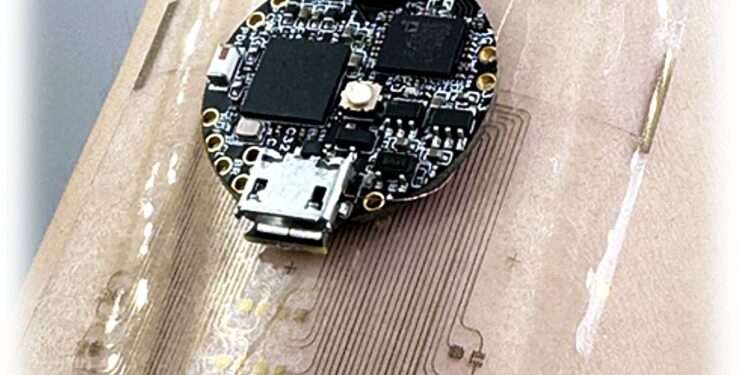Credit: Liu et al.
Organic electrochemical transistors (OECTs) are neuromorphic transistors made of carbon-based materials that combine electronic and ionic charge carriers. These transistors could provide particularly effective solutions for amplifying and switching electronic signals in devices designed to be placed on human skin, such as smart watches, trackers that monitor physiological signals, and other wearable technologies.
Unlike conventional neuromorphic transistors, OECTs could operate reliably in humid environments, which would be highly beneficial for medical and wearable devices. Despite their potential, most existing OECTs are based on rigid materials, which can reduce the comfort of wearables and thus hinder their large-scale deployment.
Researchers at the University of Hong Kong have developed a new wearable device based on stretchable OECTs that can both perform calculations and collect signals from the environment. Their proposed system, presented in a paper published in Natural electronicscould be used to realize sensor-integrated edge computing on a flexible and comfortable wearable device for users.
“The rise of AI and machine learning has been transformative and has permeated various fields,” Shiming Zhang, co-author of the paper, told Tech Xplore.
“However, their deployment in wearables, which is crucial to enabling digital health, is only just beginning. Our goal is to integrate machine learning capabilities into wearables to enable neuromorphic computing in sensors or capabilities This enables real-time results, edge-based decision making, essential for closed-loop theranostics and relevant for AI-based medicine.
As part of their study, Zhang and his colleagues set out to develop an AI-powered wearable device based on expandable OECT matrices. This first involved developing machine learning algorithms and training them on biomedical datasets to make accurate predictions about users’ physiology and health.
“To merge our algorithms with wearable devices, we face three main challenges: collecting higher quality health data for precise training, removing motion artifacts with soft skin and thus minimizing data noise, and personalizing an algorithm for maximum computing efficiency,” Zhang said.
“As a result, we use OECTs to obtain high-quality muscle EMG signals; develop scalable OECTs to minimize motion artifacts and employ a specific AI algorithm, reservoir calculation, for energy-efficient data training .”
Design strategy for a portable computing unit in a sensor (WISE platform) based on ISOECT matrices. Credit: Natural electronics (2024). DOI: 10.1038/s41928-024-01250-9
The OECTs fabricated by the researchers and integrated into the proposed wearable device consist of stretchable components, including an elastomeric substrate, a semiconductor polymer-based channel, and a solid gel electrolyte, as well as source, drain, and gold-based grid. The transistors were found to exhibit stretchability of more than 50%, reaching sizes less than 100 µm.
The researchers fabricated their stretchable transistors using a high-resolution inkjet printing system and then used them to develop an in-sensor computing module compatible with smart watches. In initial tests, this module performed remarkably well, for example predicting the hand gestures of users wearing it with around 90% accuracy.
“In this project, we synergize multidisciplinary knowledge covering materials science, manufacturing, electronics, AI and medicine,” Zhang added.
“The WISE (Wearable, Intelligent, and Soft Electronics) platform presented is universal and can be easily customized for other wearable computing applications. This system has the potential to improve health outcomes across a wide range of diseases, benefiting both patients and the general public. “.
More information:
Dingyao Liu et al, A Wearable In-Sensor Computing Platform Based on Stretchable Organic Electrochemical Transistors, Natural electronics (2024). DOI: 10.1038/s41928-024-01250-9.
© 2024 Science X Network
Quote: Stretchable transistors used in wearable devices enable sensor-integrated edge computing (October 19, 2024) retrieved October 20, 2024 from
This document is subject to copyright. Except for fair use for private study or research purposes, no part may be reproduced without written permission. The content is provided for informational purposes only.



